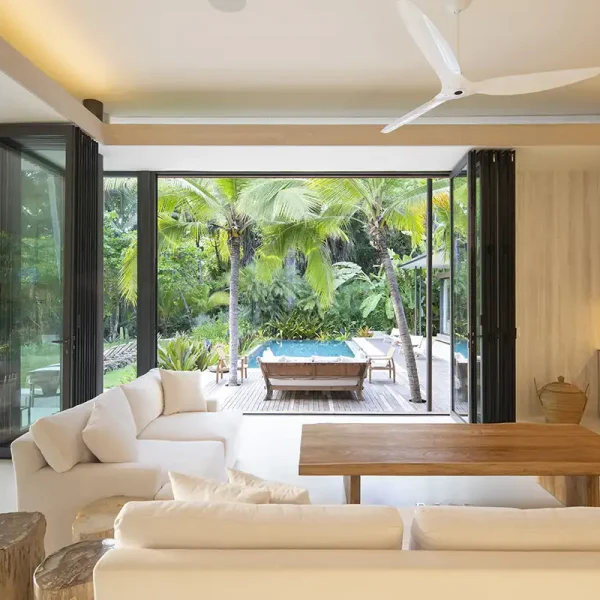In today’s design landscape, creating spaces that are both beautiful and functional is essential. Gone are the days of designing interiors and exteriors as separate entities. Modern design trends focus on integrating indoor and outdoor living, ensuring that both environments complement each other seamlessly. At AA Building Co., we believe that the right blend of interior design and functional landscaping can transform a house into a home, where every space feels connected and purposeful.
The Connection Between Interior Design and Landscaping
While interior design shapes the atmosphere and functionality of indoor spaces, landscaping defines the connection to the outside world. When these two elements work together, they create an environment that flows naturally from the inside out. The goal is to establish a cohesive design that allows for easy transitions and enhances both form and function. Whether you’re renovating a home or building from scratch, here are key ways to integrate these two disciplines.
1. Open Floor Plans that Invite the Outdoors In
One of the best ways to create a seamless transition between the interior and exterior is through open floor plans. Large windows, sliding glass doors, and expansive openings can bring in natural light and provide views of the outdoor landscape, making the indoors feel like an extension of the outdoors.
Designing a living area that opens up to a deck, patio, or garden allows you to create a fluid connection between spaces. This not only brings in more light and air but also gives you more room for entertaining, dining, or simply relaxing in nature without leaving the comfort of your home.
2. Natural Materials for a Cohesive Look
Integrating natural materials into both your interior design and landscaping creates a harmonious and organic feel. For example, wooden floors inside the home can be echoed by wooden decking or fencing outside. Stone accents, like a stone fireplace or accent walls, can also be mirrored in an outdoor stone pathway or garden walls.
Natural materials such as wood, stone, and metal don’t just enhance the aesthetic of both spaces; they also have a timeless quality that connects the home to its natural surroundings. These materials age beautifully, providing durability and a sustainable touch to your design.
3. Indoor Gardens and Greenery
Incorporating greenery into interior spaces is an easy and impactful way to blend landscaping with interior design. Indoor plants, green walls, and even small herb gardens bring the beauty of nature into the home while improving indoor air quality.
By using indoor planters, terrariums, or vertical gardens, you can create green focal points that tie back to your exterior landscape. A seamless design might include a potted plant by the window or a lush indoor garden that opens to an outdoor patio, creating a calming and organic feel throughout the space.
4. Functional Outdoor Spaces: Extending Living Areas
Landscaping isn’t just about making your garden look pretty; it’s also about creating functional spaces that extend your home’s usable area. From well-designed patios and outdoor kitchens to fire pits and seating areas, functional landscaping adds real value to your home.
Consider how you use your outdoor space and design accordingly. A shaded pergola for dining, a raised vegetable garden for growing your own food, or even a cozy lounge area with weatherproof furniture can all contribute to enhancing the overall functionality of your home’s exterior while keeping the aesthetic flow intact.
5. Lighting to Connect and Highlight Both Spaces
Lighting is one of the most effective ways to unify interior and exterior spaces, especially when the sun goes down. Strategic lighting in the garden, such as pathway lights, accent lights, and up-lights for trees, can create a warm, inviting atmosphere that extends the feeling of comfort from indoors to outdoors.
Inside, the right lighting can draw attention to key architectural features or artwork, while outdoor lighting can highlight the landscape and provide safety and ambiance. Thoughtful lighting design ensures that your spaces are usable and beautiful, no matter the time of day or night.
6. Sustainability and Smart Landscaping Choices
Sustainability is not just a trend but a necessity for creating functional and eco-friendly spaces. Opting for low-maintenance plants, drought-resistant grasses, and sustainable outdoor materials can help reduce your environmental footprint.
Moreover, selecting energy-efficient indoor lighting and appliances that complement sustainable outdoor landscaping choices ensures that both your interior design and exterior landscaping align with eco-conscious living.
Conclusion
At AA Building Co., we understand the power of merging interior design with functional landscaping. By thoughtfully designing spaces that work together, you can create a home that feels expansive, cohesive, and connected to nature. Whether it’s designing a spacious interior with seamless outdoor access or incorporating green elements inside, integrating interior design and landscaping transforms any space into a balanced and functional living environment.
When done right, interior design and landscaping don’t just coexist; they enhance one another, making your home feel more open, inviting, and truly yours.
